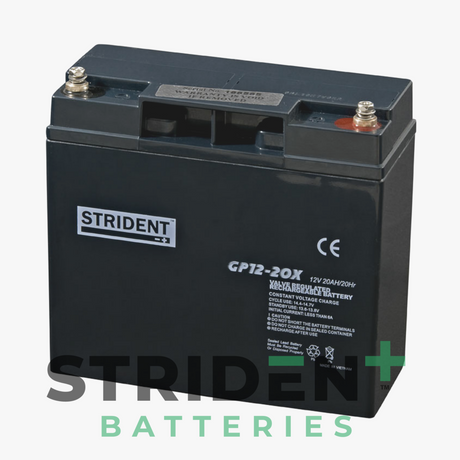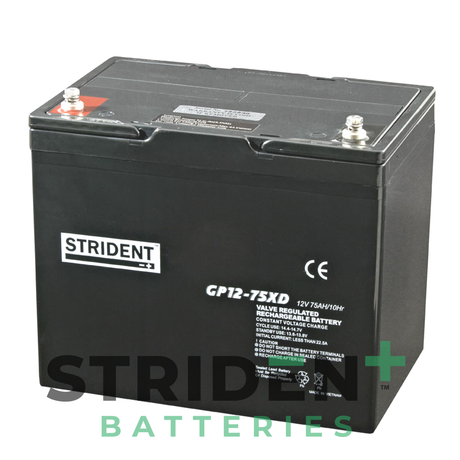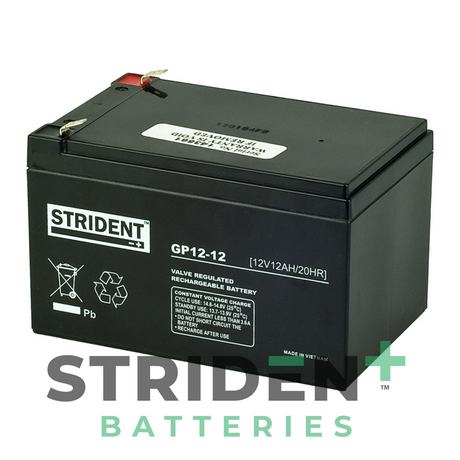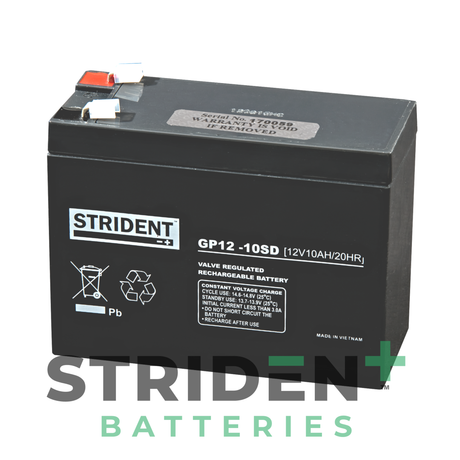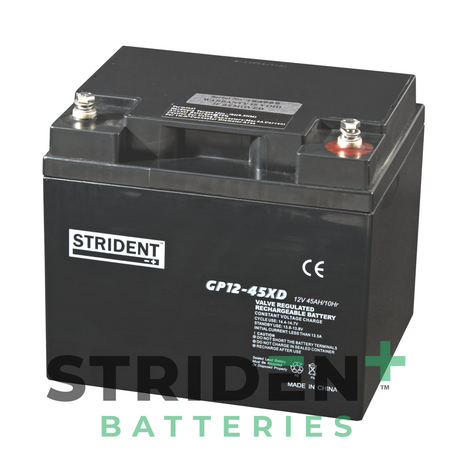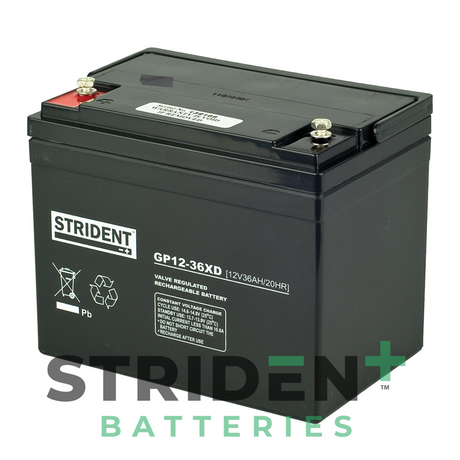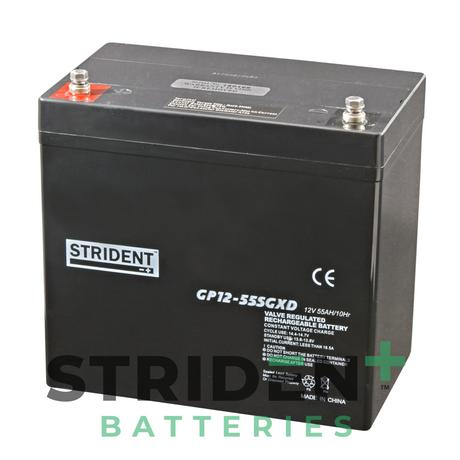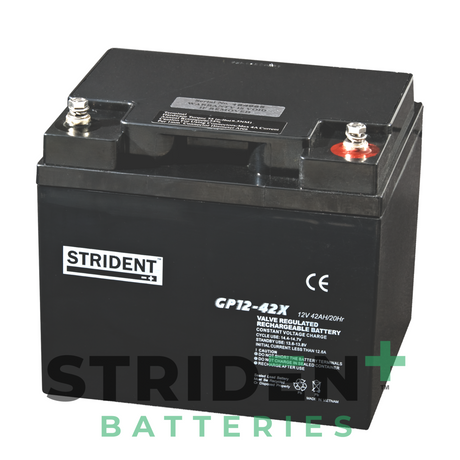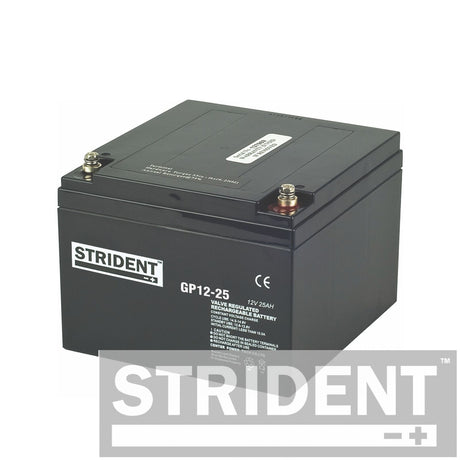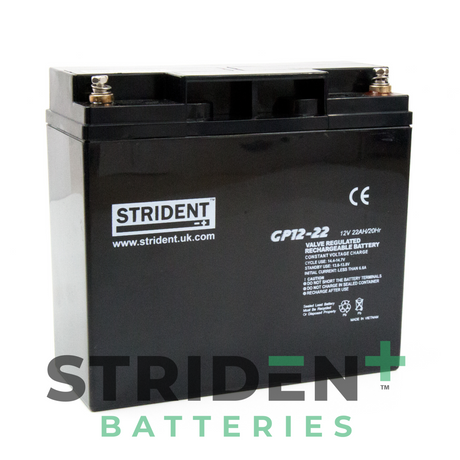Solax
Regular price£369.00 With VAT Relief
×Are You Eligible for VAT Relief?
Many of our products—such as riser recliners, adjustable beds, mobility scooters, wheelchairs, and daily living aids—can be purchased without VAT if you qualify. You may be eligible for VAT relief if you have a long-term medical condition such as arthritis, osteoporosis, diabetes, Parkinson’s, COPD, or any other chronic illness.
If your item is VAT-relief eligible, simply complete the quick VAT exemption form on the basket page. Once the form is completed, the VAT will be automatically removed. If an item is not eligible, the price will clearly show VAT included on the product listing and will therefore not be eligible for VAT relief.
If you have any questions regarding VAT relief, please feel free to contact us. We’re always happy to explain the process in more detail and answer any questions you may have.
Unit price /UnavailableStrident
2 x Strident™ AGM GP12V 20AH - Mobility Scooter / Wheelchair / Powerchair 12V Batteries (Pair)
Regular price£149.40
×Are You Eligible for VAT Relief?
Many of our products—such as riser recliners, adjustable beds, mobility scooters, wheelchairs, and daily living aids—can be purchased without VAT if you qualify. You may be eligible for VAT relief if you have a long-term medical condition such as arthritis, osteoporosis, diabetes, Parkinson’s, COPD, or any other chronic illness.
If your item is VAT-relief eligible, simply complete the quick VAT exemption form on the basket page. Once the form is completed, the VAT will be automatically removed. If an item is not eligible, the price will clearly show VAT included on the product listing and will therefore not be eligible for VAT relief.
If you have any questions regarding VAT relief, please feel free to contact us. We’re always happy to explain the process in more detail and answer any questions you may have.
Unit price /UnavailableStrident
2 X Strident 12v 75A/H Mobility Scooter Battery
Regular price£399.00
×Are You Eligible for VAT Relief?
Many of our products—such as riser recliners, adjustable beds, mobility scooters, wheelchairs, and daily living aids—can be purchased without VAT if you qualify. You may be eligible for VAT relief if you have a long-term medical condition such as arthritis, osteoporosis, diabetes, Parkinson’s, COPD, or any other chronic illness.
If your item is VAT-relief eligible, simply complete the quick VAT exemption form on the basket page. Once the form is completed, the VAT will be automatically removed. If an item is not eligible, the price will clearly show VAT included on the product listing and will therefore not be eligible for VAT relief.
If you have any questions regarding VAT relief, please feel free to contact us. We’re always happy to explain the process in more detail and answer any questions you may have.
Unit price /UnavailableStrident
2 x Strident™ AGM GP12V 12AH - Mobility Scooter / Wheelchair / Powerchair 12V Batteries (Pair)
Regular price£93.00
×Are You Eligible for VAT Relief?
Many of our products—such as riser recliners, adjustable beds, mobility scooters, wheelchairs, and daily living aids—can be purchased without VAT if you qualify. You may be eligible for VAT relief if you have a long-term medical condition such as arthritis, osteoporosis, diabetes, Parkinson’s, COPD, or any other chronic illness.
If your item is VAT-relief eligible, simply complete the quick VAT exemption form on the basket page. Once the form is completed, the VAT will be automatically removed. If an item is not eligible, the price will clearly show VAT included on the product listing and will therefore not be eligible for VAT relief.
If you have any questions regarding VAT relief, please feel free to contact us. We’re always happy to explain the process in more detail and answer any questions you may have.
Unit price /UnavailableStrident
2 x Strident™ AGM GP12V 10AH - Mobility Scooter / Wheelchair / Powerchair 12V Batteries (Pair)
Regular price£89.40
×Are You Eligible for VAT Relief?
Many of our products—such as riser recliners, adjustable beds, mobility scooters, wheelchairs, and daily living aids—can be purchased without VAT if you qualify. You may be eligible for VAT relief if you have a long-term medical condition such as arthritis, osteoporosis, diabetes, Parkinson’s, COPD, or any other chronic illness.
If your item is VAT-relief eligible, simply complete the quick VAT exemption form on the basket page. Once the form is completed, the VAT will be automatically removed. If an item is not eligible, the price will clearly show VAT included on the product listing and will therefore not be eligible for VAT relief.
If you have any questions regarding VAT relief, please feel free to contact us. We’re always happy to explain the process in more detail and answer any questions you may have.
Unit price /UnavailableStrident
2 x Strident™ AGM GP12V 50AH - Mobility Scooter / Wheelchair / Powerchair 12V Batteries (Pair)
Regular price£298.80
×Are You Eligible for VAT Relief?
Many of our products—such as riser recliners, adjustable beds, mobility scooters, wheelchairs, and daily living aids—can be purchased without VAT if you qualify. You may be eligible for VAT relief if you have a long-term medical condition such as arthritis, osteoporosis, diabetes, Parkinson’s, COPD, or any other chronic illness.
If your item is VAT-relief eligible, simply complete the quick VAT exemption form on the basket page. Once the form is completed, the VAT will be automatically removed. If an item is not eligible, the price will clearly show VAT included on the product listing and will therefore not be eligible for VAT relief.
If you have any questions regarding VAT relief, please feel free to contact us. We’re always happy to explain the process in more detail and answer any questions you may have.
Unit price /UnavailableStrident
2 x Strident™ AGM GP12V 45AH - Mobility Scooter / Wheelchair / Powerchair 12V Batteries (Pair)
Regular price£279.00
×Are You Eligible for VAT Relief?
Many of our products—such as riser recliners, adjustable beds, mobility scooters, wheelchairs, and daily living aids—can be purchased without VAT if you qualify. You may be eligible for VAT relief if you have a long-term medical condition such as arthritis, osteoporosis, diabetes, Parkinson’s, COPD, or any other chronic illness.
If your item is VAT-relief eligible, simply complete the quick VAT exemption form on the basket page. Once the form is completed, the VAT will be automatically removed. If an item is not eligible, the price will clearly show VAT included on the product listing and will therefore not be eligible for VAT relief.
If you have any questions regarding VAT relief, please feel free to contact us. We’re always happy to explain the process in more detail and answer any questions you may have.
Unit price /UnavailableStrident
2 x Strident™ AGM GP12V 36AH - Mobility Scooter / Wheelchair / Powerchair 12V Batteries (Pair)
Regular price£228.96
×Are You Eligible for VAT Relief?
Many of our products—such as riser recliners, adjustable beds, mobility scooters, wheelchairs, and daily living aids—can be purchased without VAT if you qualify. You may be eligible for VAT relief if you have a long-term medical condition such as arthritis, osteoporosis, diabetes, Parkinson’s, COPD, or any other chronic illness.
If your item is VAT-relief eligible, simply complete the quick VAT exemption form on the basket page. Once the form is completed, the VAT will be automatically removed. If an item is not eligible, the price will clearly show VAT included on the product listing and will therefore not be eligible for VAT relief.
If you have any questions regarding VAT relief, please feel free to contact us. We’re always happy to explain the process in more detail and answer any questions you may have.
Unit price /UnavailableStrident
2 x Strident™ AGM GP12V 100AH - Mobility Scooter / Wheelchair / Powerchair 12V Batteries (Pair)
Regular price£598.80
×Are You Eligible for VAT Relief?
Many of our products—such as riser recliners, adjustable beds, mobility scooters, wheelchairs, and daily living aids—can be purchased without VAT if you qualify. You may be eligible for VAT relief if you have a long-term medical condition such as arthritis, osteoporosis, diabetes, Parkinson’s, COPD, or any other chronic illness.
If your item is VAT-relief eligible, simply complete the quick VAT exemption form on the basket page. Once the form is completed, the VAT will be automatically removed. If an item is not eligible, the price will clearly show VAT included on the product listing and will therefore not be eligible for VAT relief.
If you have any questions regarding VAT relief, please feel free to contact us. We’re always happy to explain the process in more detail and answer any questions you may have.
Unit price /UnavailableStrident
2 x Strident™ AGM GP12V 55AH - Mobility Scooter / Wheelchair / Powerchair 12V Batteries (Pair)
Regular price£328.80
×Are You Eligible for VAT Relief?
Many of our products—such as riser recliners, adjustable beds, mobility scooters, wheelchairs, and daily living aids—can be purchased without VAT if you qualify. You may be eligible for VAT relief if you have a long-term medical condition such as arthritis, osteoporosis, diabetes, Parkinson’s, COPD, or any other chronic illness.
If your item is VAT-relief eligible, simply complete the quick VAT exemption form on the basket page. Once the form is completed, the VAT will be automatically removed. If an item is not eligible, the price will clearly show VAT included on the product listing and will therefore not be eligible for VAT relief.
If you have any questions regarding VAT relief, please feel free to contact us. We’re always happy to explain the process in more detail and answer any questions you may have.
Unit price /UnavailableStrident
2 x Strident™ AGM GP12V 42AH - Mobility Scooter / Wheelchair / Powerchair 12V Batteries (Pair)
Regular price£269.04
×Are You Eligible for VAT Relief?
Many of our products—such as riser recliners, adjustable beds, mobility scooters, wheelchairs, and daily living aids—can be purchased without VAT if you qualify. You may be eligible for VAT relief if you have a long-term medical condition such as arthritis, osteoporosis, diabetes, Parkinson’s, COPD, or any other chronic illness.
If your item is VAT-relief eligible, simply complete the quick VAT exemption form on the basket page. Once the form is completed, the VAT will be automatically removed. If an item is not eligible, the price will clearly show VAT included on the product listing and will therefore not be eligible for VAT relief.
If you have any questions regarding VAT relief, please feel free to contact us. We’re always happy to explain the process in more detail and answer any questions you may have.
Unit price /UnavailableStrident
2 x Strident™ AGM GP12V 25AH - Mobility Scooter / Wheelchair / Powerchair 12V Batteries (Pair)
Regular price£168.96
×Are You Eligible for VAT Relief?
Many of our products—such as riser recliners, adjustable beds, mobility scooters, wheelchairs, and daily living aids—can be purchased without VAT if you qualify. You may be eligible for VAT relief if you have a long-term medical condition such as arthritis, osteoporosis, diabetes, Parkinson’s, COPD, or any other chronic illness.
If your item is VAT-relief eligible, simply complete the quick VAT exemption form on the basket page. Once the form is completed, the VAT will be automatically removed. If an item is not eligible, the price will clearly show VAT included on the product listing and will therefore not be eligible for VAT relief.
If you have any questions regarding VAT relief, please feel free to contact us. We’re always happy to explain the process in more detail and answer any questions you may have.
Unit price /UnavailableStrident
2 x Strident™ AGM GP12V 22AH - Mobility Scooter / Wheelchair / Powerchair 12V Batteries (Pair)
Regular price£159.00
×Are You Eligible for VAT Relief?
Many of our products—such as riser recliners, adjustable beds, mobility scooters, wheelchairs, and daily living aids—can be purchased without VAT if you qualify. You may be eligible for VAT relief if you have a long-term medical condition such as arthritis, osteoporosis, diabetes, Parkinson’s, COPD, or any other chronic illness.
If your item is VAT-relief eligible, simply complete the quick VAT exemption form on the basket page. Once the form is completed, the VAT will be automatically removed. If an item is not eligible, the price will clearly show VAT included on the product listing and will therefore not be eligible for VAT relief.
If you have any questions regarding VAT relief, please feel free to contact us. We’re always happy to explain the process in more detail and answer any questions you may have.
Unit price /Unavailable
Top picks for you
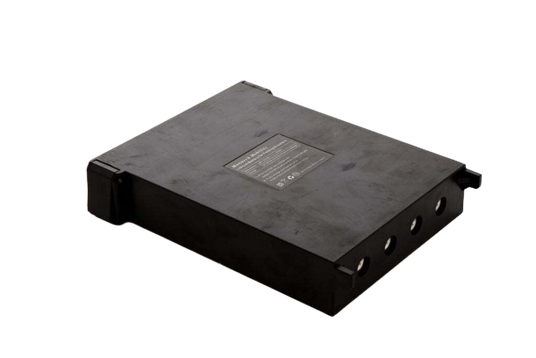
Mobility Scooter Battery Replacement- Reliable Power for Every Ride
Keep your mobility scooter running at its best with mobility scooter battery replacement from Mobility Solutions Direct. Whether you need a traditional sealed lead-acid unit or are upgrading to a mobility scooter lithium battery replacement, we stock a wide range of trusted brands to suit every model.
Each battery pack is built for reliability, ensuring you enjoy smooth, uninterrupted journeys.Choosing the Right Battery for Mobility Scooter Models
Not sure which battery for mobility scooter models is best for you? Our Mobility Scooter Batteries collection makes it simple to find a perfect fit. From compact scooters that need lightweight power to heavy-duty models requiring long-range capacity and fast chargers, we offer options that guarantee performance and durability.
If you’re uncertain, our expert team is always ready to provide tailored advice.
Benefits of Lithium Mobility Scooter Batteries
For those looking to upgrade, lithium mobility scooter batteries are an excellent choice. Unlike traditional sealed lead-acid batteries, lithium scooter batteries are lighter, charge faster, and last significantly longer- making them ideal for frequent users.
Choosing a mobility scooter lithium battery replacement also means fewer replacements over time, giving you both convenience and value for money.
Shop our wide range of mobility scooter accessories.
How to Know When It’s Time for a Mobility Scooter Battery Replacement
If your scooter is struggling to hold a charge, losing power more quickly than usual, or taking longer to recharge, it’s likely time for a mobility scooter battery replacement. Our guide on scooter battery care can help you spot the signs early, ensuring you never get caught out with a flat battery when you need your electric scooter most.
Shop now, spread the cost of purchase with Snap Finance (Representative 29.9% APR)
Free & Fast Delivery on All Mobility Scooters
At Mobility Solutions Direct, we’re proud to offer free and fast delivery on all of our mobility scooter batteries. As the UK’s trusted mobility specialist, we combine competitive pricing with expert customer service to give you peace of mind. With thousands of happy customers and a dedicated support team, we’re here to keep you moving with the correct battery.
Contact UsKeep your mobility scooter running at its best with mobility scooter battery replacement from Mobility Solutions Direct. Whether you need a traditional sealed lead-acid unit or are upgrading to a mobility scooter lithium battery replacement, we stock a wide range of trusted brands to suit every model.
Each battery pack is built for reliability, ensuring you enjoy smooth, uninterrupted journeys.Choosing the Right Battery for Mobility Scooter Models
Not sure which battery for mobility scooter models is best for you? Our Mobility Scooter Batteries collection makes it simple to find a perfect fit. From compact scooters that need lightweight power to heavy-duty models requiring long-range capacity and fast chargers, we offer options that guarantee performance and durability.
If you’re uncertain, our expert team is always ready to provide tailored advice.
Benefits of Lithium Mobility Scooter Batteries
For those looking to upgrade, lithium mobility scooter batteries are an excellent choice. Unlike traditional sealed lead-acid batteries, lithium scooter batteries are lighter, charge faster, and last significantly longer- making them ideal for frequent users.
Choosing a mobility scooter lithium battery replacement also means fewer replacements over time, giving you both convenience and value for money.
Shop our wide range of mobility scooter accessories.
How to Know When It’s Time for a Mobility Scooter Battery Replacement
If your scooter is struggling to hold a charge, losing power more quickly than usual, or taking longer to recharge, it’s likely time for a mobility scooter battery replacement. Our guide on scooter battery care can help you spot the signs early, ensuring you never get caught out with a flat battery when you need your electric scooter most.
Shop now, spread the cost of purchase with Snap Finance (Representative 29.9% APR)
Free & Fast Delivery on All Mobility Scooters
At Mobility Solutions Direct, we’re proud to offer free and fast delivery on all of our mobility scooter batteries. As the UK’s trusted mobility specialist, we combine competitive pricing with expert customer service to give you peace of mind. With thousands of happy customers and a dedicated support team, we’re here to keep you moving with the correct battery.
Contact UsFrequently Asked Questions
How long do mobility scooter batteries last?
How long do mobility scooter batteries last?
How far can a mobility scooter battery go on a full charge?
How far can a mobility scooter battery go on a full charge?
This depends on the battery type, scooter model, and user weight. Lightweight lithium batteries, like our 24V 10Ah lithium battery, means that mobility scooters can travel up to 13 miles on a single charge.


